Tips from the Experts
Creating a Featured Book Display When Most of the Books Are E-books
Patricia E. Reese
Science Librarian
Discovery Park Library
University of North Texas
Denton, Texas
Patriciae.reese@unt.edu
Abstract
The Discovery Park Library of the University of North Texas designed a physical featured book display which incorporated both print and electronic books. Using "book dummies" as the base, a template was developed which contained a book cover image and a QR code which would lead the patron to the book in the catalog. Students have used the QR codes to find books, and overall, the book display is leading to increased use of selected items
Introduction
Setting up a featured book display seems like such a simple process; you choose books on your selected topic, document in your online catalog what has happened to these books, and then set them out and watch them get checked out; but times have changed. I was tasked with creating a featured book display in the Discovery Park Library, which contains a mix of engineering and information sciences resources. While making these selections, I noticed that a large number of the books I wanted to display were online. This led to the question of how to physically display electronic books. While looking around in my office, I had an inspiration. We could use the old wooden "book dummies," formerly used in the stacks to note alternative shelving titles and other information we needed patrons to know, and turn these wood blocks into book substitutes.

I reported on this project in our libraries' weekly internal newsletter called Friday Frags, and thought nothing more about it. A few days later I was asked to present the project to our monthly Tech Talks. There seemed to be some interest in the project but I got one question from a non-librarian that took me aback: "What is a book dummy?" This gave me the idea that although the idea seems simple, it was of value to other librarians and libraries
Literature Review
There are several questions to be explored.
- What is a book dummy?
- What makes a successful book display?
- How have other libraries handled featured book displays?
Harrod's Librarians' Glossary (Prytherch 2005) defines the term shelf dummy as "a piece of wood or cardboard placed on a shelf to indicate that a specific book is shelved out of sequence." Library supply vendors sell book dummies that are meant to identify space for books on loan, reserved, at the bindery, or elsewhere (Gaylord 2013). Dummies were used in the past to indicate title changes in serials. Book dummies are basically pointers or detour signs telling users where to go next in their searches.
In an issue of the 2005 AALL Spectrum, Margie Axtmann (2005) asked the question, "Book Dummies: Useful or Obsolete?" Using law libraries as her focus, she questioned if libraries continued to use book dummies in the traditional manner, noting serials title changes, and if the accreditation agencies noted any problems with libraries not using them in that manner. Some of her correspondents reported using book dummies in other ways, such as indicating a journal was online or in a special collection, but they always directed users to other locations, allowing patrons to find materials that they needed.
Book Displays
D.N. Dutta (1961) wrote that the normal methods used in the library were not enough to reveal to users the extent of resources available to them. Book displays help bring into prominence items that would easily be overlooked.
Book displays may also increase circulation. S.L. Baker (1986) discussed studies that found prime display areas do result in increased circulation. Different experimental parameters including location and actual librarian recommendation were utilized. The article presented discussion about how narrowing the selection may help overcome 'information overload," but recommended further study.
Dowling College librarians (Aloi et al. 2007) state that books with colorful covers or jackets can generate interest in displays. They have a technical services team that creates displays for permanent mounting, rapid response topical displays (events that have a high but short-lived community interest), and traveling displays for lectures and special events on campus. To insure that the books are findable at all times, the catalog record is temporarily changed to reflect the new location (status). They add a message on the item record for display items so that if checked out they will be returned to the display. Lists of these items are generated in the system to produce circulation statistics.
The idea of using shelf dummies to represent electronic journals in the midst of a music print library was presented by Joe Clark from Kent State (Clark 2012). He discussed the shift from a print to digital collection after an extensive weeding and renovation project that left faculty members unable to find items that they were familiar with. The shelf dummies contained detailed holdings information as well as indexing that enabled patron discovery through the usage of these new finding aids. The process was not quick, but patrons appreciated the effort. He also suggested QR codes could be used as an enhancement on these dummies.
QR codes
QR or Quick Response Codes (Baker 2010) are a two-dimensional coding system that uses vertical and horizontal dimensions to store much more information than traditional one-dimensional barcodes can.
QR codes are able to store text, numbers, and URLs. With a smartphone and an app that reads the QR code, users can scan the code and retrieve the information contained in the code. QR codes have been used very successfully in Japan and Europe for multimedia advertising and informational purposes. As an example, a fast food wrapper might have a QR code that links to nutritional information (Baker 2010).
QR codes can be encoded to transmit many types of information. At UC Irvine, Kane and Schneidewind (2011) discussed QR codes as a finding aid linking electronic and print resources. Their literature review revealed QR code usage in various projects throughout libraries. These projects included information pages about QR codes and QR codes in the catalog records giving basic information about the item. Other projects included creating games and contests, linking to reservation forms, and linking to bibliographies and directories, including maps of the LOC (Library of Congress) contents in the stacks (Kane 2011).
Leigh Anne Williams (2011) in the Retail Nation section of Publishers Weekly described an idea by a Canadian bookseller to sell e-books in bookstores using cards that replicate the book cover and include a hidden code that enables the purchaser to download the book, allowing more books to be represented in bookstores that are otherwise too small.
Laura Baker (2010) described using mobile tags such as QR codes to enhance the content of a physical display. At her university, a project was developed with all freshman required to read the same book and the library created a display based on a prominent theme from the book. The book was Same Kind of Different as Me by Ron Hall and Denver Moore. The library created an exhibit with images and objects that were related to the theme of community service represented in the book. Scanning the QR code would allow for viewing videos of related events or performing real time searches in the library catalog. The codes could also link to book reviews, podcasts, and directional information, including signup sheets for community volunteer opportunities. The author explained how the QR codes can store more data than the conventional barcode and that, with an easily downloadable nonproprietary app, any smartphone allows access to this information.
In a recent issue of Issues in Science and Technology Librarianship, Tasha Maddison (2014) describes how she uses QR codes on markers attached to sturdy paper inserted in the appropriate call number location to enable patrons browsing in the physical stacks to access new e-books.
The Discovery Park Library has included QR codes on our catalog records for well over a year. Students would come up to the service desks holding up their smartphones so that staff could direct them to the book they were seeking. It is apparent that our students are using the QR code technology.
Methodology
The featured book display began with developing a list of topics relevant to the Discovery Park Library and its patrons. At this time, we house collections for use by the College of Engineering (Computer Science and Engineering, Electrical Engineering, Engineering Technology, Materials Science and Engineering, and Mechanical and Energy Engineering) and the College of Information (Learning Technologies and Library and Information Sciences). For the first year, we decided on broad departmental topics adding in sections on careers, writing, and women in engineering.
We created a list of books available on the chosen topic. The list was then checked for authorship from the University of North Texas, as we wanted to highlight our faculty authors.
We pulled the items from the stacks, and changed the locations in the catalog if they were print books. We added a note in the bibliographic record indicating the original location so that the book can easily be returned to circulation status. E-books are slightly more complex. We created a template in Word to maintain a consistent pattern. The information in the template replicates that in the catalog record: title, author, publication information, and a table of contents or summary. The book cover is imported from Amazon.com and the QR code was initially copied from the catalog. However we found that we could not effectively track usage of our selected books using the libraries' integrated library system (ILS). We then began utilizing a free web-based service to create and track our own QR codes. This enabled us to identify usage generated from the display.
The information and cover page is sized to fit on to the face of a book dummy. We also add a small UNT logo to the image if the book was authored by a UNT faculty or staff member.
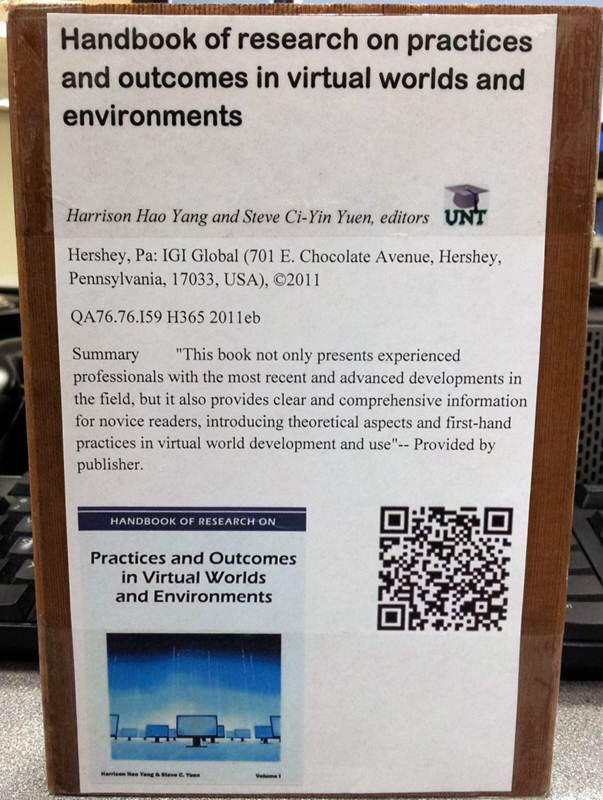
Book dummies can be purchased through library supply vendors. However, UNT has a supply of wooden books that were crafted by a staff member several years ago when book dummies were used more.
With a smartphone and a QR code reader, there is almost instant access to the text via patrons' smartphones, tablets, and e-readers.
Display Site
The display was originally located in an area that includes our reference shelves, new books, and reserves. The display area, despite prominent signage, was not very open or inviting. Essentially, it was just a continuation of the space-afflicted shelves. There was no line of sight directly to the front door and, although staged attractively using the book dummies and acrylic stands for the print books, we saw little browsing of the area. The service desk has an excellent view of patron traffic being approximately 10 feet from the shelf with nothing to impede visibility.
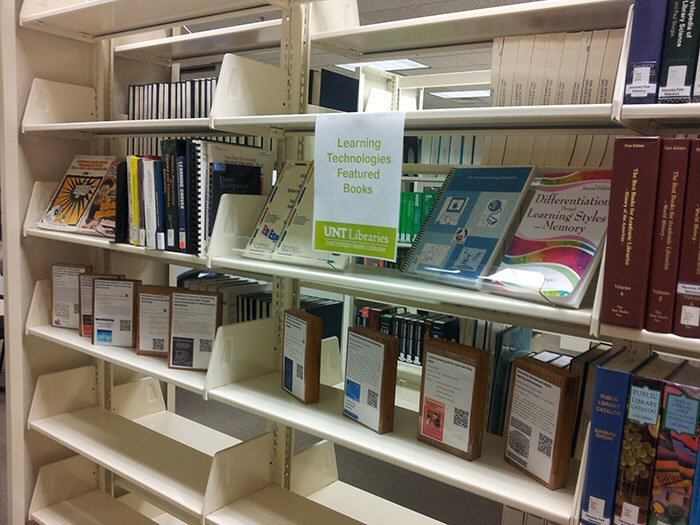
After reading the work of Jones et al. (2011), we brainstormed about the apparent lack of interest in the display. With no funds available, the only choice was to change the location of the display. This required a display area. While we had physical space, we lacked an appropriate surface. However, a wooden desk that was waiting to be transported to surplus provided a valuable flat surface and new home for our display, once it was relocated to a corner at the library's entrance.
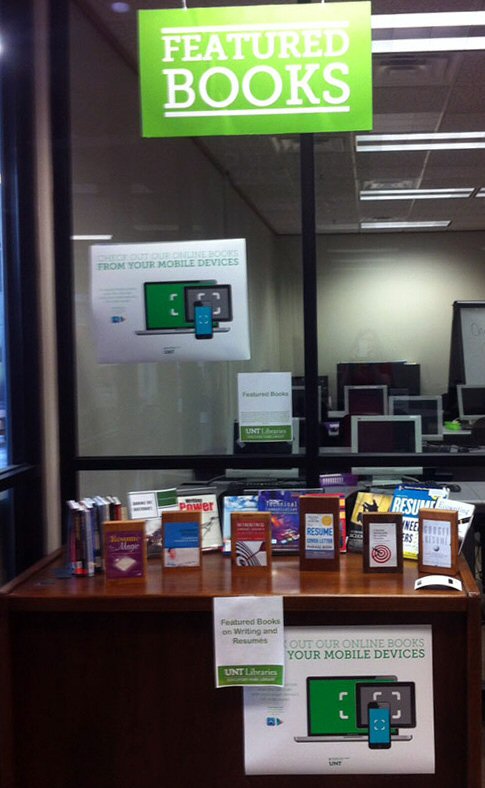
At the beginning of the fall semester, the staff decided to make a few more changes. The book dummy templates were altered to utilize both of the large flat surfaces, making it look more like a physical book. The image of the book has been enlarged to cover an area of approximately 4"x 6" and the reverse side now contains the bibliographic information along with the QR code. This has created a more interesting and colorful display.

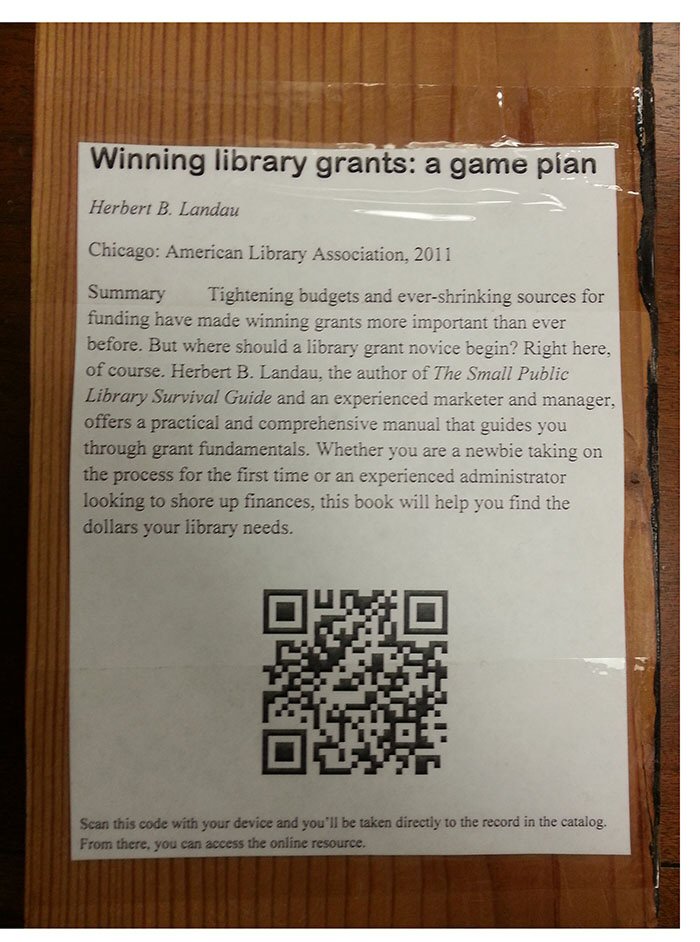
We did get a few reference questions about the display and how to use the codes, so we augmented our signage with information about how to acquire QR code readers, and then how to use them.
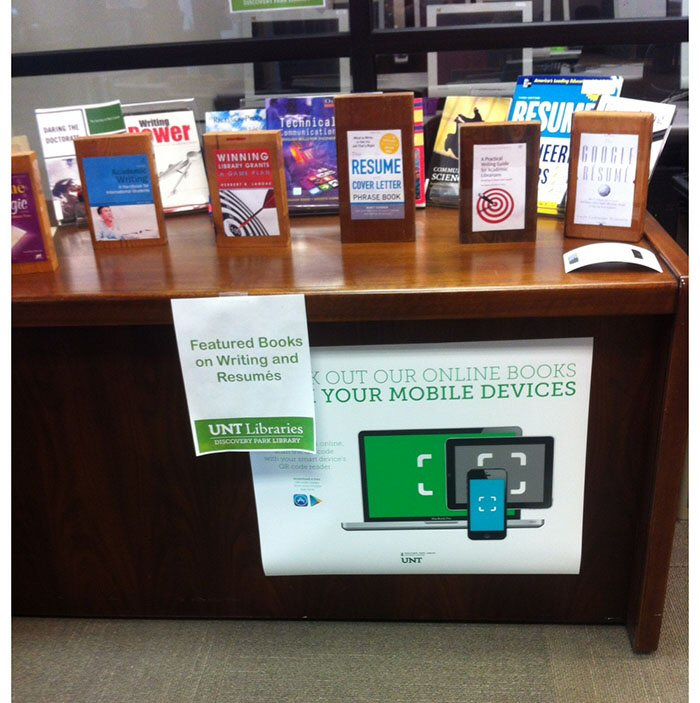
Inspired by our work with the book dummies and QR codes, we have also created a gallery showing some of our more interesting e-books. These consist of a book cover image overlaid in the corner with a QR code. These are placed in magnetic acrylic sign holders and placed in our reading room in areas likely to attract the attention of our browsing public, such as group study tables and the supply table.
Conclusion
Moving the display has generated much more interest. Everyone entering the library can see the display immediately. There are signs outside the library announcing the current month's topic. There is signage just below the display indicating the topic and a hanging sign indicating that this is the location of the featured books. Flyers announcing the current display have been placed on bulletin boards throughout our extensive building. Flyers contain both the topic of the month and several images from the selected books. The flyers have been successful as several people came in specifically to borrow books on the flyer. Imagine their excitement when they discovered a whole desk full of physical and electronic books on the topic!
Future Plans
We plan to investigate QR code capabilities and track usage of featured e-books in a more controlled manner. Our first attempt of tracking usage failed when the tracking program changed from a free service to one that is fee based. We have had some discussions with the systems librarian but there are difficulties singling out the individual items and dates through the ILS. We are currently experimenting with the Google link shortener and a dedicated Gmail account to track our usage.
Pilot studies at UC Irvine (Kane and Schneidewind 2011) have shown that QR code usage can be successful and we and our colleagues are eager to explore them further.
References
Aloi, M.J., Esposito, L., Gotsch, J.R., Holliday, D., and Kretz, C. 2007. Technology of displays. Technical Services Quarterly 24(4):15-27. DOI: 10.1300/J124v24n04_02
Axtmann, M. 2005. Book dummies: Useful or obsolete? AALL Spectrum 9(7):8-9.
Baker, L. 2010. Making physical objects clickable: Using mobile tags to enhance library displays. Journal of Library Innovation 1(2):22-28.
Baker, S.L. 1986. The display phenomenon: An exploration into factors causing the increased circulation of displayed books Library Quarterly 56(3):237-257.
Clark, J.C. 2012. Connecting print patrons to electronic holdings with shelf dummies. Serials Review 38(4):250-253. DOI: 10.1016/j.serrev.2012.10.003
Definition of "Shelf dummy." 2005. In R. Prytherch. Harrod's librarians' glossary and reference book. England: Ashgate. p.638.
Dutta, D.N. 1960/61. Display of books in the library. Journal of Library Science (4):5-8.
Gaylord. 2014. Book dummy. Available from http://www.gaylord.com/search?text=book+dummy
Jones, D.Y., McCandless, M., Kiblinger, K., Giles, K. and McCabe, J. 2011. Simple marketing techniques and space planning to increase circulation. Collection Management 36(2):107-118. DOI: 10.1080/01462679.2011.553774
Kane, D. and Schneidewind, J. 2011. QR codes as finding aides: Linking electronic and print library resources. Public Services Quarterly 7(3-4):111-124. DOI: 10.1080/15228959.2011.623599
Maddison, T. 2014. E-resource discovery: A collection development strategy for engineering e-books. Issues in Science and Technology Librarianship 75 [Internet]. [Cited 07/11/14]. Available from http://www.istl.org/14-winter/tips.html
Williams, L. 2011. Bringing e-books to stores. Publishers Weekly 258(21):15.
Acknowledgements
I would like to express my appreciation to Ms. Melissa Diehl who has provided expert technical assistance with all aspects of this project.
| Previous | Contents | Next |

This work is licensed under a Creative Commons Attribution 4.0 International License.
